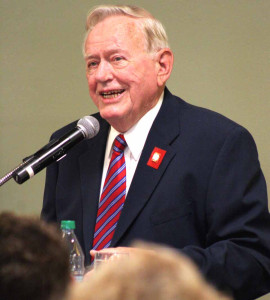Dr. Brenner Celebrates
SUNY Presidents, Values
By LIBBY CUDMORE • allotsego.com

ONEONTA – “This isn’t your grandparent’s college, or even your parents,” said Dr. David Brenner, the retired associate director of academic affairs at SUNY Oneonta.
But one thing has remained across generations — the college’s commitment to values.
Brenner was on hand to discuss these values and the history of the college at a luncheon celebrating “Red Day,” the 125th anniversary of SUNY Oneonta’s founding as a Normal School on Sept. 4, 1889. “I see the possibilities full of promise,” said principal James A. Milne at the dedication. “Today we dedicate, tomorrow we change possibility into reality.”
Milne was president until 1898, when Percy Bugbee was appointed. In one of his final speeches, Milne told the gathered faculty, “Institutions are greater than men. This institution is greater than any man or set of men.”
Bugbee, Brenner said, was persistent, building up enrollment and encouraging teachers to teach at rural schools. He told students at the 1911 commencement, “The greatest consideration of one’s life is to do right,” and in 1927, “Have a smile for disaster, a cheer for every brave deed, a hand quick to help, and a heart warm with everyday human kindness.”
But Bugbee didn’t fully utilize by these virtues in his faculty, denying teachers the opportunity to pursue higher degrees or new ideas. Dr. Hunt, who took over the presidency in 1933, encouraged faculty to collaborate, use visual aids and focused on establishing the college “up the hill,” the foundation for which would become SUNY Oneonta.
For Dr. Royal Netzer, 1951-1960, those values were shown on the ground. “He was frequently seen in a ditch inspecting a waterline or determining of a bid specification was being met,” said Brenner. “He presided over the greatest period of growth the college has seen.”
Dr. Craven presided over the college during the Vietnam War. “We had people teaching students to make pipe bombs,” he said. “We had to identify these people and deal with them.”
But the individual was of the utmost important to Craven. “He opened more outreach programs to the community,” said Brenner. “The decade was spent focusing on the individual students.”
When SUNY insisted that the college add 300 to it’s enrollment, Dr. Alan Donovan refused. “He didn’t want this to be a place where you came if you’d failed to get into four or five other schools,” said Brenner. “This was a selective school.”
It was a daring tactic, but one that worked, and now, under Dr. Nancy Kleniewski, those values have continued, making SUNY Oneonta the recipient of multiple national honors and awards. “Her valies are Oneonta’s,” said Brenner. “And we can wish for nothing more.”

